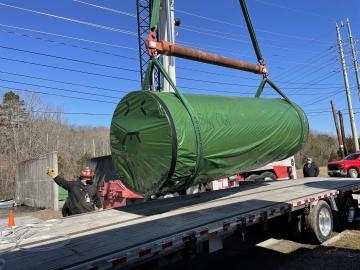
Filter News
Area of Research
- (-) Computer Science (19)
- (-) Fusion and Fission (54)
- (-) Isotopes (35)
- Advanced Manufacturing (34)
- Biological Systems (18)
- Biology and Environment (177)
- Biology and Soft Matter (5)
- Building Technologies (12)
- Chemical and Engineering Materials (4)
- Chemistry and Physics at Interfaces (11)
- Clean Energy (522)
- Climate and Environmental Systems (14)
- Computational Biology (6)
- Computational Chemistry (5)
- Computational Engineering (5)
- Data (1)
- Earth Sciences (1)
- Electricity and Smart Grid (3)
- Energy Frontier Research Centers (14)
- Energy Sciences (5)
- Fossil Energy (3)
- Fuel Cycle Science and Technology (3)
- Functional Materials for Energy (16)
- Fusion Energy (17)
- Geographic Information Science and Technology (3)
- Isotope Development and Production (3)
- Materials (433)
- Materials Characterization (2)
- Materials for Computing (36)
- Materials Synthesis from Atoms to Systems (13)
- Materials Under Extremes (12)
- Mathematics (1)
- National Security (79)
- Neutron Data Analysis and Visualization (4)
- Neutron Science (190)
- Nuclear Science and Technology (74)
- Nuclear Systems Modeling, Simulation and Validation (3)
- Nuclear Systems Technology (1)
- Quantum Condensed Matter (4)
- Quantum information Science (9)
- Reactor Technology (1)
- Renewable Energy (4)
- Sensors and Controls (5)
- Supercomputing (311)
- Transportation Systems (11)
News Type
News Topics
- 3-D Printing/Advanced Manufacturing (3)
- Advanced Reactors (6)
- Artificial Intelligence (7)
- Big Data (4)
- Bioenergy (1)
- Biology (1)
- Biomedical (6)
- Buildings (2)
- Chemical Sciences (4)
- Climate Change (1)
- Composites (1)
- Computer Science (17)
- Critical Materials (1)
- Cybersecurity (1)
- Decarbonization (2)
- Energy Storage (6)
- Environment (4)
- Exascale Computing (2)
- Fossil Energy (1)
- Frontier (1)
- Fusion (22)
- Grid (4)
- High-Performance Computing (4)
- Irradiation (1)
- Isotopes (25)
- ITER (6)
- Machine Learning (4)
- Materials (5)
- Materials Science (6)
- Microscopy (1)
- Nanotechnology (1)
- National Security (1)
- Net Zero (1)
- Neutron Science (1)
- Nuclear Energy (29)
- Partnerships (3)
- Physics (1)
- Quantum Science (3)
- Security (2)
- Simulation (3)
- Space Exploration (4)
- Summit (1)
- Sustainable Energy (6)
- Transportation (2)
Media Contacts

Diego Del-Castillo-Negrete, a distinguished staff member in the Fusion Energy Division, was cited for Outstanding Technical Achievement – National Laboratory. He will be recognized during the GMiS annual conference, which will be held virtually Oct. 11-22. The HENAAC awards program is in its 33rd year.

A 25-year career with the U.S. Navy, commanding combat missions overseas, brought Tom Kollie back to where he came from — ready to serve his country in a new way.

As a medical isotope, thorium-228 has a lot of potential — and Oak Ridge National Laboratory produces a lot.

The receipt of a nuclear fuel canister is boosting the research of an Oak Ridge National Laboratory team investigating methods to help the nation effectively dispose of nuclear waste for the long term.

Four first-of-a-kind 3D-printed fuel assembly brackets, produced at the Department of Energy’s Manufacturing Demonstration Facility at Oak Ridge National Laboratory, have been installed and are now under routine operating

Joseph Pickel has been elected a 2021 fellow of the American Chemical Society, or ACS. Pickel supports the Fusion and Fission Energy and Sciences Directorate as environment, safety and health

To minimize potential damage from underground oil and gas leaks, Oak Ridge National Laboratory is co-developing a quantum sensing system to detect pipeline leaks more quickly.

An Oak Ridge National Laboratory researcher has invented a version of an isotope-separating device that can withstand extreme environments, including radiation and chemical solvents.

Equipment and expertise from Oak Ridge National Laboratory will allow scientists studying fusion energy and technologies to acquire crucial data during landmark fusion experiments in Europe.

Oak Ridge National Laboratory researchers designed and field-tested an algorithm that could help homeowners maintain comfortable temperatures year-round while minimizing utility costs.


